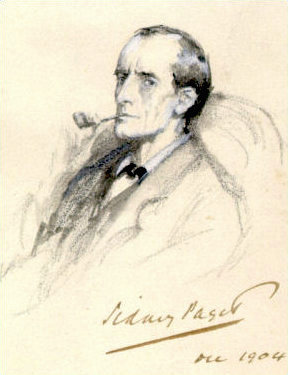
Sherlock Holmes is a fictional detective created by British author Arthur Conan Doyle. Referring to himself as a "consulting detective" in his stories, Holmes is known for his proficiency with observation, deduction, forensic science and logical reasoning that borders on the fantastic, which he employs when investigating cases for a wide variety of clients, including Scotland Yard.

A Study in Scarlet is an 1887 detective novel by British writer Arthur Conan Doyle. The story marks the first appearance of Sherlock Holmes and Dr. Watson, who would become the most famous detective duo in English literature. The book's title derives from a speech given by Holmes, a consulting detective, to his friend and chronicler Watson on the nature of his work, in which he describes the story's murder investigation as his "study in scarlet": "There's the scarlet thread of murder running through the colourless skein of life, and our duty is to unravel it, and isolate it, and expose every inch of it."
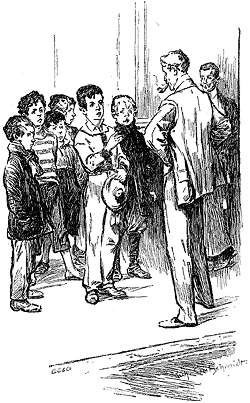
The Baker Street Irregulars are fictional characters who appear in three Sherlock Holmes stories, specifically two novels and one short story, by Arthur Conan Doyle. They are street boys who are employed by Holmes as intelligence agents. The name has subsequently been adopted by other organizations, most notably a prestigious and exclusive literary society founded in the United States by Christopher Morley in 1934.
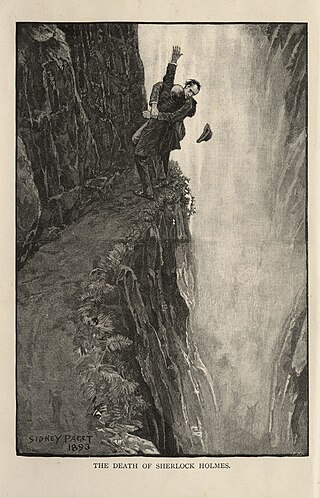
"The Final Problem" is a short story by Sir Arthur Conan Doyle featuring his detective character Sherlock Holmes. It was first published in The Strand Magazine in the United Kingdom, and McClure's in the United States, under the title "The Adventure of the Final Problem" in December 1893. It appears in book form as part of the collection The Memoirs of Sherlock Holmes.

Sherlock Holmes in the 22nd Century is an animated television series in which Sherlock Holmes is brought back to life in the 22nd century. The series is a co-production by DIC Entertainment, L.P. and Scottish Television Enterprises and was nominated for a Daytime Emmy for Special Class Animated Program.

The Valley of Fear is the fourth and final Sherlock Holmes novel by British writer Arthur Conan Doyle. It is loosely based on the Molly Maguires and Pinkerton agent James McParland. The story was first published in the Strand Magazine between September 1914 and May 1915. The first book edition was copyrighted in 1914, and it was first published by George H. Doran Company in New York on 27 February 1915, and illustrated by Arthur I. Keller.

Detective Inspector G. Lestrade, or Mr. Lestrade, is a fictional character appearing in several of the Sherlock Holmes stories written by Arthur Conan Doyle. Lestrade's first appearance was in the first Sherlock Holmes story, the novel A Study in Scarlet, which was published in 1887. The last story in which he appears is the short story "The Adventure of the Three Garridebs", which was first published in 1924 and was included in the final collection of Sherlock Holmes stories by Doyle, The Case-Book of Sherlock Holmes.

"The Adventure of the Norwood Builder", one of the 56 short Sherlock Holmes stories written by Sir Arthur Conan Doyle, is the second tale from The Return of Sherlock Holmes. The story was first published in Collier's (US) on 31 October 1903 and in The Strand Magazine (UK) in November 1903.

Colonel Sebastian Moran is a fictional character in the stories written by Arthur Conan Doyle. An enemy of Sherlock Holmes, he first appears in the 1903 short story "The Adventure of the Empty House". Holmes once described him as "the second most dangerous man in London", the most dangerous being Professor Moriarty, Moran's employer.

Without a Clue is a 1988 British comedy film directed by Thom Eberhardt and starring Michael Caine and Ben Kingsley. It is based on Sir Arthur Conan Doyle's characters from the Sherlock Holmes stories but, in this version, the roles are reversed: Dr. John Watson is the brilliant detective, while "Sherlock Holmes" is an actor hired to pose as the detective so that Watson can protect his reputation as a physician.
Sherlock Holmes has long been a popular character for pastiche, Holmes-related work by authors and creators other than Arthur Conan Doyle. Their works can be grouped into four broad categories:
Many writers make references to Sir Arthur Conan Doyle's famous literary creation, the detective Sherlock Holmes, and these often become embedded within popular culture. While Holmes exists predominantly in the context of Victorian-era London, he has been mentioned in such outre contexts as the 22nd century or hunting aliens or supernatural enemies. These references are in addition to the innumerable passing references to Sherlock Holmes made in many literary and cinematic works, such as the labeling of a person as a "Sherlock", whether in reference to their intelligence.
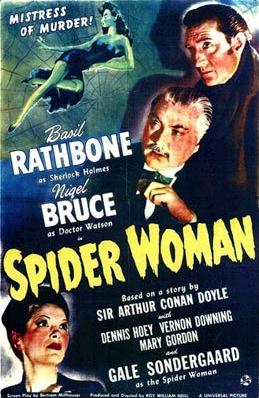
The Spider Woman is a 1943 mystery film starring Basil Rathbone as Sherlock Holmes and Nigel Bruce as Dr. Watson, the seventh of fourteen such films the pair were involved in. As with all of the Universal Studios films in the series, the film is set in then-present day as opposed to the Victorian setting of the original stories. This film incorporates elements from the 1890 novel The Sign of the Four, as well as the short stories "The Final Problem", "The Adventure of the Empty House", "The Adventure of the Speckled Band" and makes explicit reference to "The Adventure of the Devil's Foot".
"A Study in Emerald" is a short story written by British fantasy and graphic novel author Neil Gaiman. The story is a Sherlock Holmes pastiche transferred to the Cthulhu Mythos universe of horror writer H. P. Lovecraft. Gaiman describes it as "Lovecraft/Holmes fan fiction". It won the 2004 Hugo Award for Best Short Story. The title is a reference to the Sherlock Holmes novel A Study in Scarlet.

Traditionally, the canon of Sherlock Holmes consists of the 56 short stories and four novels written by Sir Arthur Conan Doyle. In this context, the term "canon" is an attempt to distinguish between Doyle's original works and subsequent works by other authors using the same characters. Usually capitalized by aficionados of the Sherlockian game as "the Canon", the description of these 60 adventures as the Sherlock Holmes canon and the game of applying the methods of "Higher Criticism" to it was started by Ronald Knox as a playful use of the traditional definition of canon as an authoritative list of books accepted as holy scripture.

Sherlock Holmes and the Secret Weapon (1942) is the fourth in the Basil Rathbone/Nigel Bruce series of 14 Sherlock Holmes films which updated the characters created by Sir Arthur Conan Doyle to the then present day. The film is credited as an adaptation of Conan Doyle's 1903 short story "The Adventure of the Dancing Men," though the only element from the source material is the dancing men code. Rather, it is a spy film taking place on the background of the then ongoing Second World War with an original premise. The film concerns the kidnapping of a Swiss scientist by their nemesis Professor Moriarty, to steal a new bomb sight and sell it to Nazi Germany. Sherlock Holmes and Dr. John Watson have to crack a secret code in order to save the country.

The Triumph of Sherlock Holmes is a 1935 British mystery film directed by Leslie S. Hiscott and starring Arthur Wontner. It was based on the 1915 Sherlock Holmes novel The Valley of Fear by Arthur Conan Doyle.
This article describes minor characters from the Sherlock Holmes stories by Sir Arthur Conan Doyle, and from non-canonical derived works. The list excludes the titular character as well as Dr. Watson, Professor Moriarty, Inspector Lestrade, Mycroft Holmes, Mrs. Hudson, Irene Adler, Colonel Moran, the Baker Street Irregulars, and characters not significant enough to mention.
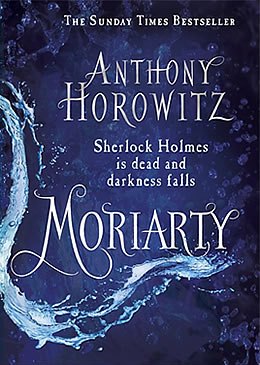
Moriarty is a Sherlock Holmes novel written by author Anthony Horowitz and published in 2014. It is the follow-up, but not a sequel, to his previous novel The House of Silk.
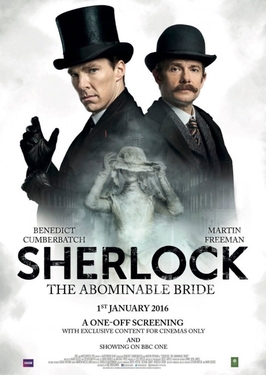
"The Abominable Bride" is a special episode of the British television programme Sherlock. The episode was broadcast on BBC One, PBS and Channel One on 1 January 2016. It depicts the characters of the show in an alternative timeline: the Victorian London setting of the original stories by Arthur Conan Doyle. The title is based on the quote "Ricoletti of the club foot and his abominable wife" from "The Adventure of the Musgrave Ritual" (1893), which refers to a case mentioned by Holmes. The story also draws on elements of original Conan Doyle stories of Holmes such as "The Five Orange Pips" (1891) and "The Final Problem" (1893).















